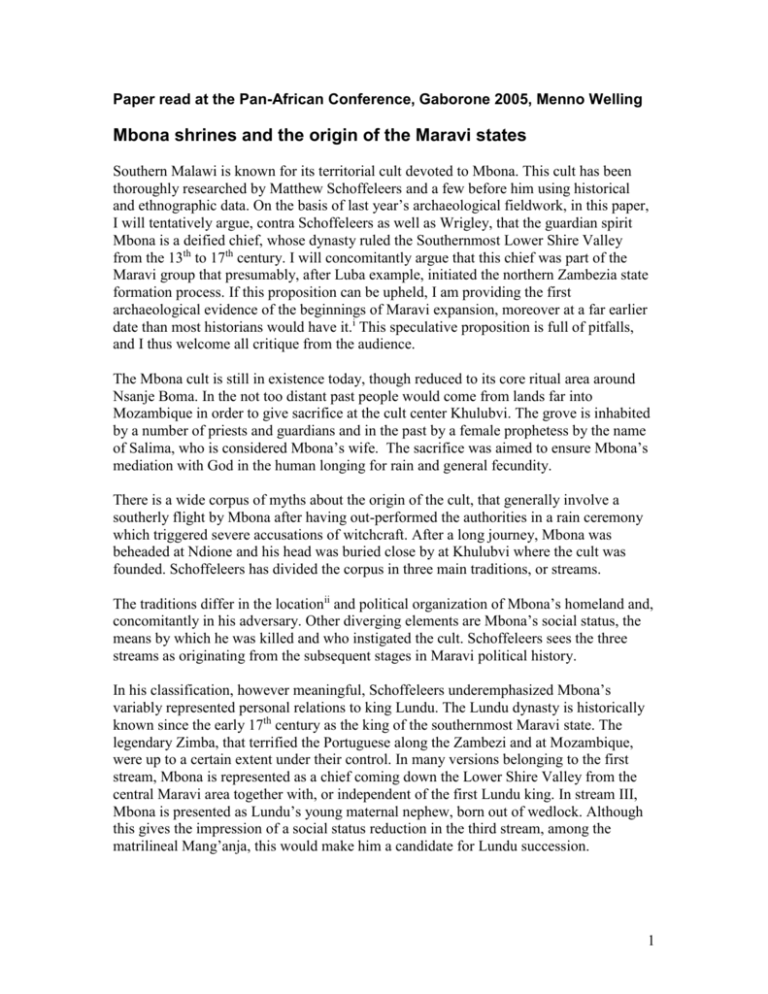Mbona shrines and the origin of the Maravi states: Presenting
advertisement

Paper read at the Pan-African Conference, Gaborone 2005, Menno Welling Mbona shrines and the origin of the Maravi states Southern Malawi is known for its territorial cult devoted to Mbona. This cult has been thoroughly researched by Matthew Schoffeleers and a few before him using historical and ethnographic data. On the basis of last year’s archaeological fieldwork, in this paper, I will tentatively argue, contra Schoffeleers as well as Wrigley, that the guardian spirit Mbona is a deified chief, whose dynasty ruled the Southernmost Lower Shire Valley from the 13th to 17th century. I will concomitantly argue that this chief was part of the Maravi group that presumably, after Luba example, initiated the northern Zambezia state formation process. If this proposition can be upheld, I am providing the first archaeological evidence of the beginnings of Maravi expansion, moreover at a far earlier date than most historians would have it.i This speculative proposition is full of pitfalls, and I thus welcome all critique from the audience. The Mbona cult is still in existence today, though reduced to its core ritual area around Nsanje Boma. In the not too distant past people would come from lands far into Mozambique in order to give sacrifice at the cult center Khulubvi. The grove is inhabited by a number of priests and guardians and in the past by a female prophetess by the name of Salima, who is considered Mbona’s wife. The sacrifice was aimed to ensure Mbona’s mediation with God in the human longing for rain and general fecundity. There is a wide corpus of myths about the origin of the cult, that generally involve a southerly flight by Mbona after having out-performed the authorities in a rain ceremony which triggered severe accusations of witchcraft. After a long journey, Mbona was beheaded at Ndione and his head was buried close by at Khulubvi where the cult was founded. Schoffeleers has divided the corpus in three main traditions, or streams. The traditions differ in the locationii and political organization of Mbona’s homeland and, concomitantly in his adversary. Other diverging elements are Mbona’s social status, the means by which he was killed and who instigated the cult. Schoffeleers sees the three streams as originating from the subsequent stages in Maravi political history. In his classification, however meaningful, Schoffeleers underemphasized Mbona’s variably represented personal relations to king Lundu. The Lundu dynasty is historically known since the early 17th century as the king of the southernmost Maravi state. The legendary Zimba, that terrified the Portuguese along the Zambezi and at Mozambique, were up to a certain extent under their control. In many versions belonging to the first stream, Mbona is represented as a chief coming down the Lower Shire Valley from the central Maravi area together with, or independent of the first Lundu king. In stream III, Mbona is presented as Lundu’s young maternal nephew, born out of wedlock. Although this gives the impression of a social status reduction in the third stream, among the matrilineal Mang’anja, this would make him a candidate for Lundu succession. 1 With regard to the historical nature of Mbona, Schoffeleers has shifted position. Initially he regarded the guardian spirit Mbona as a deified historical rain priest, a clear case of euhemerism. Subsequently, in response to charges by Wrigley of denying Africans the ability of believing in spiritual beings other than deceased persons, Schoffeleers in his 1992 magnus oper maintained the 16th century –and I quote– “Zimba experience resulted in a profound transformation of a preexisting mythical discourse in the sense that it changed Mbona from an ahistorical into a historical deity and from an essentially malign or at least highly ambiguous deity into an essentially benign deity”.iii Schoffeleers no longer perceived Mbona to have been an historical person, but postulates that those involved started perceiving him as such in this time of social upheaval and tightening political control. As part of my dissertation research into the Lundu Mbona dynamics, I have conducted excavations at sites associated with Mbona. I have reported earlier on the work at Mbewe ya Mitengo, the presumed initial Lundu capital and the sacrificial site of Chifunda Lundu. Suffices to say here that a 150 hectare 12th or early 13th century site was found. Presently, I will present the findings of test excavations at the remaining sites, which were allowed after discussion with the cult leadership under strict conditions. The site of Mwalaumodzi, first reported by Rangeley, is locally known for the granite rock in the Thangadzi Riverbed which carries the buttock imprints of Mbona, where he supposedly rested on his way south. At least up to the beginning of the last century, it was the location of a shrine devoted to him. The smooth depressions seem to have been caused by axe grinding by stone tool using hunter-gatherers. At the opposite North bank, an abundance of microliths was encountered, providing further material evidence of its presumed makers. In addition, however, pottery was found dating to all ages with the exception of Nkhudzi. Two test excavations failed to produce an undisturbed LSA layer. A mawudzu deposit was dated to the 14th century. In response to Ben Smith’s paper on Monday, I presume the pottery deposits to be occupational rather than sacrificial. As a matter of interest, in the Lower Shire Valley pottery occurrences are almost exclusively found on the North bank of rivers, which we can consider as indirect evidence of southerly expansion and threats coming from the Zambezi valley in the south. From Mwalaumodzi he reputedly went to Jambawe were he dug for water in a rock and where the rice he spilled sprouted, leaving water and food for subsequent travelers. Lacking a Mozambican permit, no archaeological investigation was conducted here. The rice has been identified as common, cultivated Oryza sativa. According to myth, on Mt Malawi, Mbona left his scarification marks in the rock. These are known as Nyembo za Chipeta. Chipeta being an old ethnonym of the people from the hills in the Maravi Heartland. Elsewhere he is said to have left his initial. On the basis of writings of Livingstone and others it is likely that the mountain top harboured a Mbona 2 shrine in the mid-nineteenth century. There is no recollection of this now, but the name Mwanalunduiv –Child of Lundu– for a river originating in the mountain range might be indicative of this. Again in response to Ben Smith no rock art was found on the mountain, nor other evidence of ancient forager activity, though survey conditions and methodology were not adequate to this effect. Coming down the mountain Mbona surrendered and had himself killed. According to myth, the blood flowing out of his body formed the present river Ndione. Up to the 1950s People gave sacrifice at a shrine in the grove. There are some indications for the more distant past that human sacrifice occasionally took place. As one can see on the aerial photograph this sacred grove is located on an old levee of the Shire River. Also note Khulubvi and Nsanje Boma, both of which are situated on the edge of the current flooding zone. At the sacred pool of Ndione, pottery was found scattered in a wide area, bearing resemblance to channeled mawudzu (Cole-King 1973) as well as Longwe, as described by Robinson. Close to the former place of sacrifice there, this ware made up a 2m thick deposit. The lowest level dating to the second half of the 12th to 13th century. The top level dating to sometime in the 17th or 18th century. The pottery was a little thicker and with a coarser matrix than the usual channeled mawudzu/longwe. Impressed decoration, other then circular stamping, were practically absent. Other finds include reed-impressed dagga, –suggestive of split reed and daub architecture–, some slag, pot stand fragments, a wound blue bead and a piece of copper wire. In the Khulubvi grove, at the bottom of one of the three 1x1m test pits we were allowed to excavate a few shards of similar channeled mawudzu/longwe pottery turned up, overlying these was a thick 18th to 19th century layer with Nkhudzi pottery.v Denser deposits were found to the east immediately outside the sacred grove. The extent of which is hard to assess as it is to be found at 50cm to a meter and a half meter below surface. Shovel test pits showed it to extend at least 400m in North easterly direction.vi It was dated to the 13th century.vii At several instances an EIW Nkope deposit was found underneath. Immediately to the south of the grove, partly in current floodlands, a thin wide scatter of more typical mawudzu is apparent. Sadly, no reliable date could be obtained. A fourth large Mawudzu site was encountered in the modern town of Nsanje Boma. 3 Recapitulating, we have seen that the Mbona shrines are, or were located at salient landmarks or, and this concerns the two most important shrines, on 12/13th century settlements. These are the sites were Mbona was allegedly killed, and where his head was buried. On the basis of these finds, I dare to speculate the mythical Mbona is a representation of a historical chief transformed in collective memory. Or more precisely, he is the representation of a dynasty of chiefs practising nominal reincarnation, who had their residence at those sites. The statement that his head was taken to Khulubvi could be indicative of it being the perceived place of origin of the last Mbona incumbent –just as today the urban deceased are taken back to there native villages. But there is more than just archaeological evidence for the contention that Mbona was an historical chief. As demonstrated by Schoffeleers, the name Malawi is suggestive of a royal Maravi capital. Also, the Karonga capital Mankhamba, just discussed by Yusuf Juwayeyi, is situated at the foot of a Mount Malawi. Could the Semancaca of the Godinho map I showed you, be this lost Maravi capital? If so the three largest sites discussed here are likely candidates for its physical localization, notwithstanding the lack of wealth and import indicative of social stratification. Mbona, about whom oral traditions are unanimous in saying that he was a Phiri, alias Maravi, is a likely candidate for having been its chief, or king.viii The rainmaking ritual he is purported to have performed, involving the pointing of a knife in all directions, is a chiefly ritual.ixx It has been described in recent times for chief Tengani, a junior to the Lundu residing some 50km to the north. More importantly a similar ritual was described by the early 17th century Portuguese Dominican Dos Santos for the King of the Zimba “If it rains when he does not wish it to do so, or it is too hot, he shoots arrows at the sky for not obeying him”. We may wonder if Mbona himself is the subject of this description, or whether it is the Lundu king, whose Zimba warriors are actually responsible for bringing an end to the Mbona chieftaincy –Note the Zimba leader Tundu is locally remembered as an evil spirit. Either way, it is the king or chief who is responsible for fertilityxi and his wife was the prophetess.xii A further argument in my case for a historical, chiefly status for Mbona is the mid-19th century occurrence of the title Bona for the senior Mang’anja chief Mongazi on the Shire highlands, as mentioned by Rowley. A bridge between this 19th century Mongazi and the ancient Lower Shire Mbona is forged by the former existence of a second Khulubvi in that very area, as attested in the Blantyre district book of 1891. In addition, 16th century Portuguese reports mention Mongazi in the Zambezi and Lupata area as an ethnonym. Schoffeleers has demonstrated this to be a Mang’anja group. 4 Lastly, I would like to add that pleading a case for euhemerism in Zambezia, home of the mhondoro cults seems like preaching the obvious. For Wrigley, coming from Uganda and the bachwezi complex it may have appeared less so. I thus come to the conclusion that Mbona headed a Maravi chiefdom in the southernmost Shire valley. This originated in the first half of the 13th century at the latest. If the Mbona chiefdom dates to the early 13th century, the senior Lundu and Karonga kingdoms must predate this. For the Lundu kingdom, I have some indications to that effect. The location of the pre-Mankhamba Karonga capital at Manthimba from oral tradition may provide the evidence ‘at the Maravi heartland’. Till then, my contentious argument may be the best there is. i Schoffeleers has suggested a 14th century date, but Newitt puts it in the late 16th century. ii Flight from Mbewe or kapirinthiwa IN CENTRAL REGION REMEMBERED AS CHIEF THUS PARSYMONY iii Before could have been could have been conceived of as zoomorphic, ahistoric after that as antropomorf an dhistoric p157 [ thus perception no truth!!!] iv Or Salima? Named mwanalundu to disguise the fact that she is actuallynot a mwanalundu but from the local chief … v On a side note the dagga imprints and plastering stone… vi Now edge floodzone those days to? vii 95.4% probability 1200AD (93.4%) 1310AD 1360AD ( 2.0%) 1380AD Unless it was Lundu who was later forced to move up. ix and which could still be performed today by the shrine officials x Or was rainmaker now chief taking control. But spear is chiefly regalia xi Acc to schof this is 17th century shift in LSV. Was rainmaker. xii Or shift from Makewana tradition? viii 5






